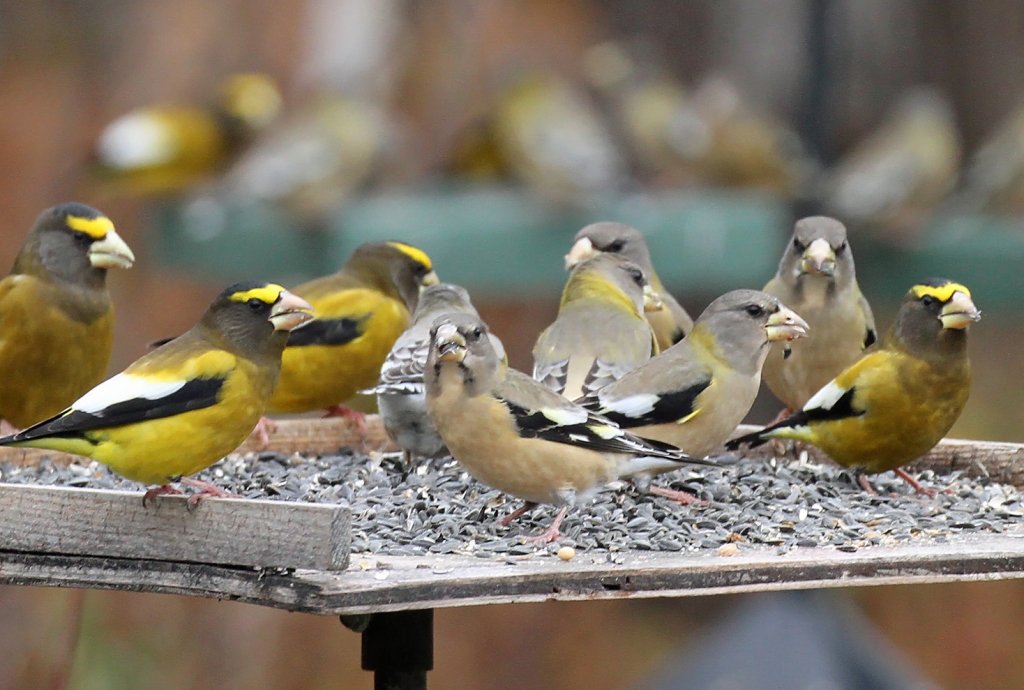Goodbye Fall Migration, Welcome Wintering Birds
Wisconsin is home to over 300 species of birds and thousands of birding enthusiasts. Explore the links below for information on birds, bird identification, birding locations and how to get involved in conservation efforts.
Sign up to receive the latest birding reports and other bird news here.
STATEWIDE BIRDING REPORT AS OF NOV. 14, 2022
Once common in the state, populations of evening grosbeaks have declined dramatically since the 1980s. Thanks to new outbreaks of spruce budworms – a key summer food source – in the Canadian boreal forest, the species has rebounded slightly in recent years. These attractive finches are frequenting Wisconsin feeders in relatively good numbers so far this season. Photo by Ryan Brady.Winter-like weather has finally arrived, bringing the tail end of bird migration season that we’d expect this time of year. Tundra swans are being seen by the hundreds now at traditional areas along the Mississippi River, Goose Pond in Columbia County and the vicinity of Green Bay. Numbers will build until ice cover forces them eastward to mid-Atlantic wintering grounds. Other waterfowl are plentiful now as well, including a variety of divers and dabblers at most water bodies. Large numbers of red-breasted mergansers were seen recently migrating south off the Lake Michigan shore, highlighted by 10,000+ at Manitowoc on Nov. 12. Lake Michigan is also a great location for spotting long-tailed ducks and all three scoter species. Some loons continue to be seen, but peak numbers have passed. Greater yellowlegs made their usual last pass through the region in the first half of the month, as did a few long-billed dowitchers, dunlin and Wilson’s snipe, but expect few to linger now.
The first snowy owls have arrived, though only in very small numbers at this point. Check out our snowy owl webpage for the latest update. Open habitats now host rough-legged hawks by day and some short-eared owls at dusk and dawn, among the more common species like red-tailed hawks, northern harriers and American kestrels. Look for northern shrikes and snow buntings in these areas as well. Golden eagles have arrived in wintering areas in the Driftless Area of western Wisconsin. Bald eagle numbers are increasing too as cold and snow begin to push them southward out of Canada. Big flocks of Sandhill Cranes were reported from many agricultural and wetland areas, some migrating out of the state with the past few days’ cold northerly winds.
Perhaps the fall’s biggest bird news so far is an irruption of evening grosbeaks statewide and across the eastern United States. Flocks are unusually common across the north woods and some have reached southern areas like Milwaukee, Madison and Chicago. This author had the pleasure of tallying over 1,000 individuals as they actively migrated along the Lake Superior shore on Nov. 3. Look and listen for them at natural tree seeds like ash, boxelder and maple, or attract them to your yards with open platform feeders, sunflower seeds and a water source. Other winter finches are only slowly moving into the north woods, including pine grosbeaks, common redpolls, red crossbills and pine siskins. Purple finches and red-breasted nuthatches are showing well in the south, while blue jays are particularly numerous in the north this year. American goldfinches are plentiful statewide.
Rare birds spotted recently include sharp-tailed sandpiper in Manitowoc county, lark bunting in Ozaukee and brant in Door. Others of interest were parasitic jaeger in Racine; Ross’s geese in Ashland, Milwaukee and Sheboygan; cattle egrets most notably in Lincoln and Dunn; and harlequin ducks in several Lake Michigan counties, including the long-staying and strikingly-plumaged males in Sheboygan. A few Baltimore orioles linger and any late hummingbirds should be photographed and carefully scrutinized now. Two exceptional finds lately were Anna’s hummingbird and Mexican Violetear. Please report your observations of rare and common species alike at Wisconsin ebird.
– Ryan Brady, DNR Natural Heritage Conservation Program Biologist







